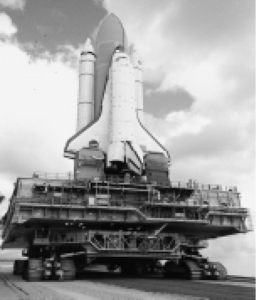ADTs Keep Shuttle Level Before Launch
With all that goes into launching the Shuttle, it’s easy to forget about the many preparations that proceed the actual flight. One of the more critical steps in this process is moving the spacecraft into place. This challenging task is accomplished using a massive Crawler/Transporter. Resting on top are the Mobile Launching Platform and the Shuttle, which are slowly carried from the Vehicle Assembly Building to the LaunchPad.

Working with a prime contractor to NASA, several of our Model 0605 ADTs will be incorporated into the Transporter’s leveling and steering systems. They are replacing rotary potentiometers, which did not satisfy the specified accuracy requirements and wore out too quickly. The ADTs will be used for angular position feedback on servovalves located throughout the Crawler. Some of these servovalves are linked to pump drives that control the steering function for each of the four double‑tracked bogies. Other servovalves control the jacking, equalizing, and leveling of the Launching Platform as the Transporter negotiates a 5% ramp leading up to the LaunchPad. So precise are these systems that the tip of the orbiter is kept vertical within 10 minutes of an arc, or about the diameter of a basketball during the 5-hour journey.